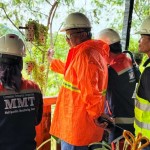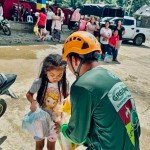Art workshop inspires cultural preservation They felt there had to be something more to life. Consumed by day-to-day domestic responsibilities that seem hopelessly demanding, their creative energy – like women everywhere — goes toward merely getting the job done. Family, home, farm – — in a post-conflict zone at that. “Subanon women are hungry for knowledge,” commented instructor Don Gurrea, during an Art Workshop initiated by TVI Resource Development (Phils.), Inc. (TVIRD) for the indigenous women in Sitio Canatuan, Siocon, Zamboanga del Norte, the host community of the Company’s gold-copper project. “They are creative and eager to learn,” added Gurrea, the Coordinator for Visual Arts of the National Commission for Culture and the Arts (NCAA) and President of the Zamboanga del Norte Federation of Visual Artists (ZANFEVA).  Fostering creativity, Gurrea said, opens up the individual to enjoyment in the process of working towards goals. “Instead of viewing creativity as a product, creativity becomes the power that feeds one’s spirit towards making a simple task of drawing a house into a joyous and fulfilling experience of actually designing a simple space into a sanctuary where the children and husband will always be happy to come home to.” Gurrea adds: “Creativity is a process of transformation. Women must find ways to observe, listen and let in all that their senses can bring them.” That transformation began last February 8 when Gurrea conducted a Functional Art Workshop for 45 women from Canatuan and neighboring Sitio Backroad, Sitio Gulangan, Sitio Paduan, Sitio Tanuman, and Barangay Makiang. (A Barangay is the smallest Philippine political unit, while a Sitio is a sub-unit of a Barangay – ed) Through TVIRD’s Community Relations and Development Office (CReDO), Gurrea teamed up with fellow ZANFEVA artists Aldrin Elman and Rudy Pahayahay in teaching the women the basics of sculpture, weaving, and other visual artworks. At the end of the session, Gurrea – a Fine Arts graduate of the University of the Philippines (Diliman) and once an Assistant Curator of the Malacanang Museum – described the outputs as “unique and very creative.” In fact, they can even be marketable, he said. CReDO Officer Elvie Asuan observed: “Most of the women participants are housewives. Some of them have farms like Lydia and Zenaida Dandana. Others do backyard gardening. This (crafting artworks) could be an additional income generating activity for them.”
Fostering creativity, Gurrea said, opens up the individual to enjoyment in the process of working towards goals. “Instead of viewing creativity as a product, creativity becomes the power that feeds one’s spirit towards making a simple task of drawing a house into a joyous and fulfilling experience of actually designing a simple space into a sanctuary where the children and husband will always be happy to come home to.” Gurrea adds: “Creativity is a process of transformation. Women must find ways to observe, listen and let in all that their senses can bring them.” That transformation began last February 8 when Gurrea conducted a Functional Art Workshop for 45 women from Canatuan and neighboring Sitio Backroad, Sitio Gulangan, Sitio Paduan, Sitio Tanuman, and Barangay Makiang. (A Barangay is the smallest Philippine political unit, while a Sitio is a sub-unit of a Barangay – ed) Through TVIRD’s Community Relations and Development Office (CReDO), Gurrea teamed up with fellow ZANFEVA artists Aldrin Elman and Rudy Pahayahay in teaching the women the basics of sculpture, weaving, and other visual artworks. At the end of the session, Gurrea – a Fine Arts graduate of the University of the Philippines (Diliman) and once an Assistant Curator of the Malacanang Museum – described the outputs as “unique and very creative.” In fact, they can even be marketable, he said. CReDO Officer Elvie Asuan observed: “Most of the women participants are housewives. Some of them have farms like Lydia and Zenaida Dandana. Others do backyard gardening. This (crafting artworks) could be an additional income generating activity for them.”  And the women agreed: “This is a good start because we would like to be organized to come up with a livelihood project,” said Zenaida. According to Asuan, the Workshop will be conducted regularly as part of the Company’s Social Development and Management Plan (SDMP) for the host Subanon indigenous community in the 508-hectare area covered by TVIRD’s Minerals Production Agreement (MPSA) with the Philippine Government. “We hope to deliver one project for each of TVIRD’s ten impact barangays this year,” Asuan explained. “These projects will be worked out with barangay leaders and will have to fall within the four categories of sustainable development, namely, education, health and sanitation, livelihood and capacity-building.” The Art Workshop, Asuan said, is part of preparations for building the capacity of Subanons for self-determination. “Helping them rekindle creativity in themselves also helps bring creativity into multiple areas in their lives, including relationships, work related to both family and home, personal interests, and aesthetic sensitivities. This diversion of creative efforts may result in different levels of creativity that can be applied to work and to the daily demands of being a housewife and a mother.” While marveling at their handiwork, the women realized that there was so much more they can do. They are, in fact, planning to put up a product display area or a souvenir shop in Canatuan. As Zenaida put it: “More than a potential livelihood project, we envision a Subanon Museum to showcase the rich culture and tradition of our ancestors, of our men and women today, for our children and for the world to understand us better and learn from our history.” (Rochelle Hilario)
And the women agreed: “This is a good start because we would like to be organized to come up with a livelihood project,” said Zenaida. According to Asuan, the Workshop will be conducted regularly as part of the Company’s Social Development and Management Plan (SDMP) for the host Subanon indigenous community in the 508-hectare area covered by TVIRD’s Minerals Production Agreement (MPSA) with the Philippine Government. “We hope to deliver one project for each of TVIRD’s ten impact barangays this year,” Asuan explained. “These projects will be worked out with barangay leaders and will have to fall within the four categories of sustainable development, namely, education, health and sanitation, livelihood and capacity-building.” The Art Workshop, Asuan said, is part of preparations for building the capacity of Subanons for self-determination. “Helping them rekindle creativity in themselves also helps bring creativity into multiple areas in their lives, including relationships, work related to both family and home, personal interests, and aesthetic sensitivities. This diversion of creative efforts may result in different levels of creativity that can be applied to work and to the daily demands of being a housewife and a mother.” While marveling at their handiwork, the women realized that there was so much more they can do. They are, in fact, planning to put up a product display area or a souvenir shop in Canatuan. As Zenaida put it: “More than a potential livelihood project, we envision a Subanon Museum to showcase the rich culture and tradition of our ancestors, of our men and women today, for our children and for the world to understand us better and learn from our history.” (Rochelle Hilario) 



